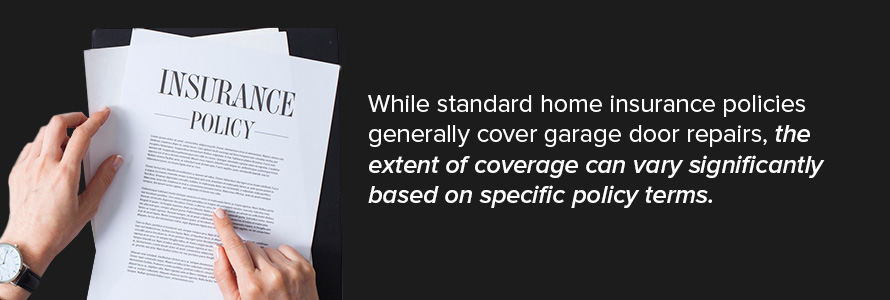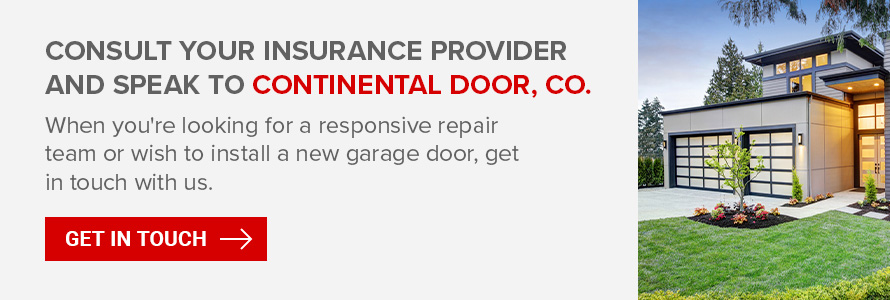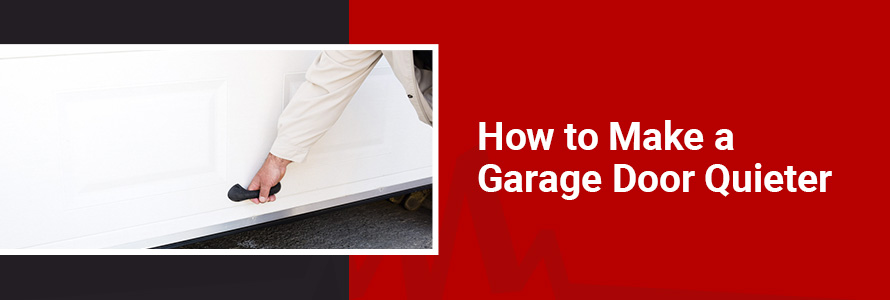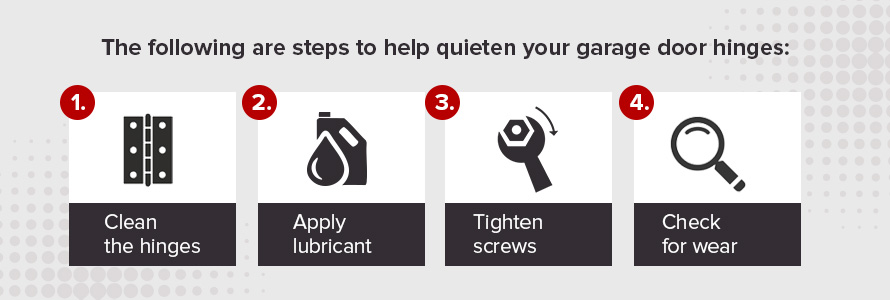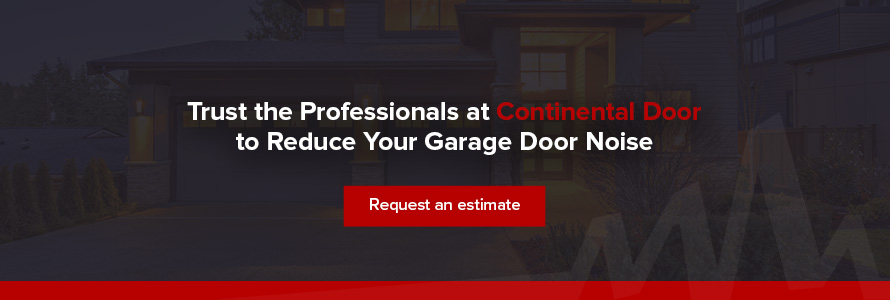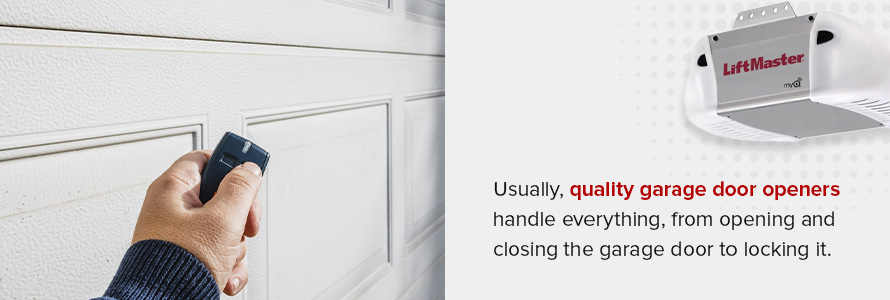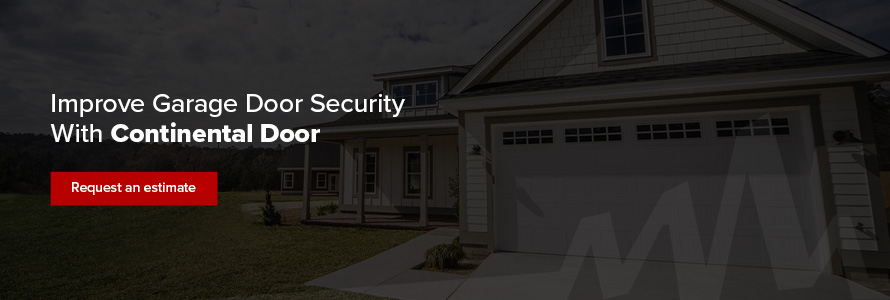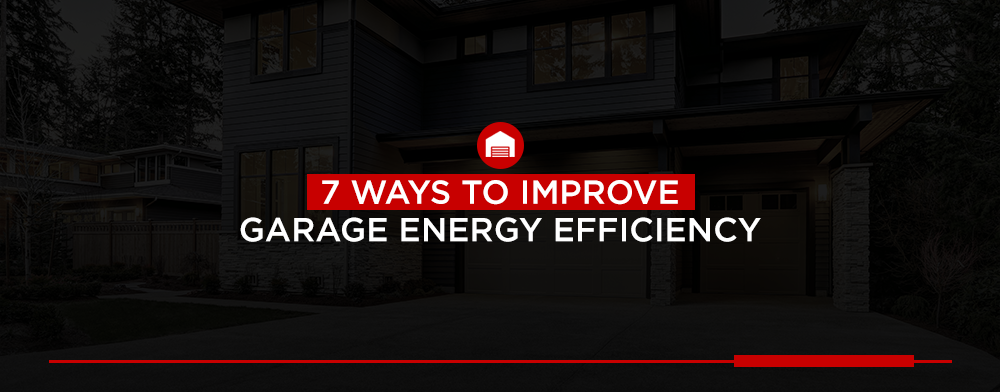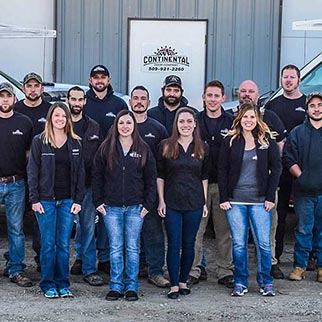Protecting Garage Doors From Water Damage
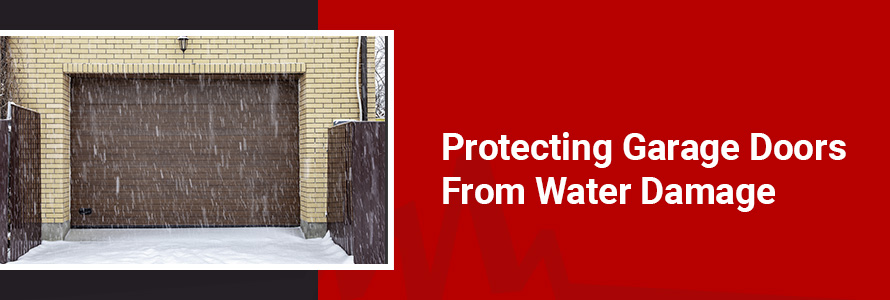
Your garage door is integral to the protection and security of your home. Severe weather conditions — especially heavy rainfalls and storms — can penetrate the door, compromise the system’s effectiveness, and cause expensive water damage.
How do you waterproof your garage door? This guide highlights how to protect your garage door to combat leaks that can negatively impact your space.
Common Garage Door Water Damage Issues
The following are common signs of water damage and the potential impacts on your garage door system:
- Rust and corrosion: You may notice rust or corrosion on the panel and other parts of metal doors. For nonmetal doors, corrosion on internal metal components like tracks and springs is a major sign of water intrusion.
- Warping and swelling: This is common with wooden garage doors that have absorbed water, leading to swelling and decay.
- Mold and mildew growth: Constant moisture creates the ideal environment for mold and mildew to thrive.
- Discoloration and stains: Water seeping into your garage door often causes discoloration and stains on the paint or floor.
- Cracks or peeling paint: Excess moisture can cause the garage door material to swell, leading to peeling paint or cracks.
Aside from visual signs of water damage, there are performance issues related to water damage, such as difficulty operating the door and unusual noises. These signs usually indicate structural damage.
Waterproof Garage Door Seals
Knowing the risks water poses, what can you put on your garage door to keep water out? The solution is installing weather-resistant seals, which offer additional benefits that improve protection and functionality, such as:
- Extending door life span: Using weather seals to limit exposure to the elements slows down wear and tear, reducing the risk of premature garage door replacements and maximizing your door’s service life.
- Preventing leaks: Weather seals prevent precipitation and moisture from seeping through the garage door and causing water-related damage such as swelling, decay and mold.
- Improving energy efficiency: Gaps around the garage door can allow conditioned air to escape and outside drafts to enter your space. Sealing these gaps regulates garage temperature, reducing energy costs.
- Blocking dust and debris: Wind and storms can significantly impact garage doors, blowing in dust and debris, which buildup on the door and impair performance. Proper sealing keeps the door’s system cleaner, reducing potential operational issues.
- Keeping out pests: Weather seals are an effective barrier against insects, mice and other pests that may enter the garage through gaps around the door.
Types of Garage Door Seals to Consider
Weather seals vary based on their function and material, so knowing the types you need to weatherproof your garage door is important. Also known as weatherstripping, these seals are made of flexible materials designed to line the edges of the door to fill gaps. Common materials to choose from include rubber, vinyl and silicone. The type of weatherstripping you use varies depending on where you need it.
Top and Side Seals
These effective seals block gaps at the top and sides of the garage door. Installation depends on the material and manufacturer’s mounting design. Some of these seals come with an adhesive side that you strip and press onto the door, while others, like vinyl weatherstripping, may require additional tools to secure it to the door’s frame.
While installing weatherstripping seems like a quick DIY project, consider professional garage door services to avoid damaging your garage door or frame. An expert will know the appropriate seal type for different parts of your door.
Bottom Seals
The bottom garage door seal is a common weatherstripping designed to line the bottom of the door. When placed, the seal sits between the bottom edge of the door and the floor, effectively sealing any gaps when the door closes. Since bottom seals are lined along the bottom of garage doors, they move with the doors when opening and closing.
Threshold Seals
These are different types of weatherstripping for the garage door’s bottom edge. Unlike a bottom seal, which attaches to the door, a threshold seal is installed directly on the garage floor using adhesives. While threshold seals are an alternative for the garage door base, they often work best alongside the bottom seals to create a strong barrier against the elements.
Preventative Maintenance Plans
Garage doors need regular preventative maintenance to ensure optimal performance and longevity.
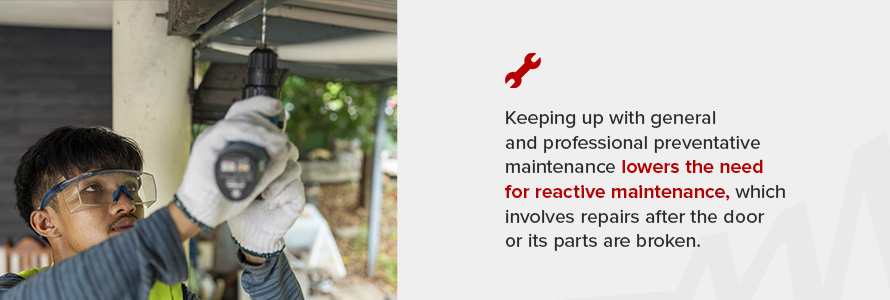
Keeping up with general and professional preventative maintenance lowers the need for reactive maintenance, which involves repairs after the door or its parts are broken. Waiting for your garage door system to break down before having a professional inspect it can be an expensive mistake.
Schedule periodic professional servicing, especially before winter. Other times, however, the following general maintenance tips will help prevent water damage:
- Inspect and replace seals: Working weatherstripping keeps water out. Inspection allows you to identify and replace worn seals for optimal moisture protection.
- Clean and lubricate the door: Frequently cleaning the door removes dirt, debris and road salt, which can accumulate and cause rust. Lubricate moving parts to keep them moisture-free and ensure the door closes well.
- Maintain proper drainage: Rainwater or melted snow should not flow directly to your garage door. Remove and combat puddles by creating a drench drain to redirect water away from the door.
- Clean the gutters: Clogged gutters located above the garage door can pour rainwater on the door. Clearing these gutters allows water to flow effectively.
When to Call a Garage Door Professional
If you already notice signs of water damage on your garage door, call professionals. Besides impairing performance, structural damage can seriously impact the door’s life span. Remember that minor damage can quickly snowball into major issues requiring heavy repairs or a total replacement.
Seeking professional repair services from experts like Continental Door takes the guesswork out of repairs, saving you money and likely saving your garage door. Our quick response team will visit your home, examine the damage and offer necessary repairs. We have garage door parts from all the top brands on the market to ensure quality replacements.
Depending on our expert analysis, we’ll advise on whether repairing or updating your garage door to a newer model is best. We have a diverse inventory of beloved collections, such as Avante®, Canyon Ridge® Louver and Bridgeport™ Steel.
Protect Your Garage Door With Continental Door
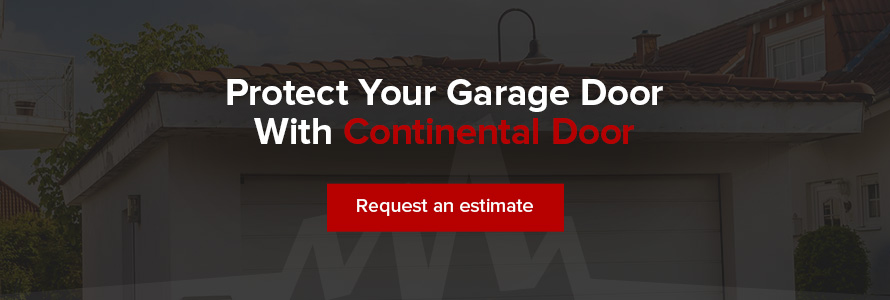
Waterproofing is key to protecting your garage door from water damage. Make waterproofing part of your overall preventative maintenance plan for a comprehensive approach to garage door upkeep. Call the experts at Continental Door for reliable garage door services and emergency 24-hour repairs.
We service residents of the Greater Spokane and Coeur d’Alene areas and the entire Inland Northwest. Contact Continental Door for professional assistance!
Does Home Insurance Cover Your Garage Door?
Homeowners insurance does cover garage doors in some circumstances. As a homeowner, you want to ensure you’re prepared should you need to repair or replace your garage door. Discover the ins and outs of when home insurance may cover garage door damage.
Understanding Home Insurance and Garage Door Coverage
Garage doors are sometimes covered by home insurance. Explore when you’ll typically be covered and situations where your insurer may not cover the damage.
What Is Typically Covered?
These are some of the common instances where you are likely covered:
- Damage from windstorms, hail and lightning strikes: You are typically covered against weather-related perils like lightning strikes, hail and wind. Even so, it is a good idea to invest in a garage door that can withstand heavy winds and extreme weather.
- Fire damage: If a fire breaks out in your garage or home and damages the garage door, your policy usually covers the repair or replacement costs. Damage from soot and smoke is included.
- Break-ins: Break-ins that damage your garage door are generally covered by insurers.
- Vehicle damage: If a vehicle accidentally damages your garage door, your policy often covers the repair costs. Auto insurance may come into play in some scenarios, which we’ll cover in greater depth below.
Exceptions and Exclusions
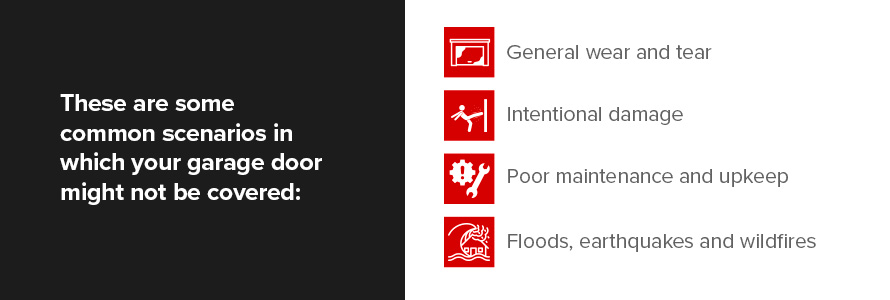
There are certain exceptions and exclusions to understand. Additionally, depending on how comprehensive your insurance is, specific damage may or may not be covered. These are some common scenarios in which your garage door might not be covered:
- General wear and tear: Damage caused by normal wear and tear is typically not covered by home insurance policies, and you will need to cover the repair expense.
- Intentional damage: If the insurer finds that the damage was caused intentionally by the homeowner or other residents, it is excluded from coverage.
- Poor maintenance and upkeep: If the damage is due to a lack of proper garage door maintenance and long-term neglect, your insurer will likely not cover the repairs.
- Floods, earthquakes and wildfires: Standard home insurance policies often exclude damage caused by certain natural disasters, such as floods, earthquakes and wildfires. You can usually add endorsements or separate policies to ensure you are covered in the event of such disasters.
A Closer Look at What Is and Isn’t Covered
Understanding the extent of your home insurance coverage is crucial. Explore some specific circumstances below.
Does Homeowners Insurance Cover Detached Garage Doors?
Detached garages often require separate coverage under an “other structures” policy because they are not attached to your home. Without one of these policies, damage to your detached garage might not be covered, and you would be responsible for covering the costs of repairs or full garage door replacement.
Attached garages are typically covered under your standard home insurance policy. However, you should always check your policy details to ensure you are adequately covered for either type of garage door.
Does Home Insurance Cover Garage Door Repairs?
While standard home insurance policies generally cover garage door repairs, the extent of coverage can vary significantly based on specific policy terms. Factors such as the type of damage, the cause and the policy’s coverage limits play crucial roles in determining how much the insurer will potentially pay out.
For instance, some policies may fully cover repairs and damage caused by falling trees or theft, while others might have exclusions or require higher deductibles. Additionally, certain policies might offer extra endorsements for enhanced protection.
It is essential to review your policy details and consult with your insurance provider to understand the exact terms and extent of your coverage.
Does Home Insurance Cover Garage Door Springs?
Home insurance generally covers garage door springs if the damage was due to a covered peril, such as fire or theft. However, damage from general wear and tear or poor maintenance is typically not covered. To be sure, check your policy’s specific details.
Does Car Insurance Cover Hitting a Garage Door?
If you accidentally hit your garage door with your car, your homeowners insurance policy will typically cover the damage done to the door. If you have collision coverage, you can likely use it to cover the damage to your vehicle. However, in some circumstances, auto insurance can cover damage to garage doors. For example, if someone else’s vehicle hits your garage door, their liability car insurance should cover the damage.
Filing a Claim for Garage Door Damage
Knowing how to file a claim streamlines and quickens the repair process when your garage door sustains damage. Here are the steps to take when filing a claim:
- Assess the damage: Inspect the damage and take detailed photos and videos as evidence.
- Determine who is at fault: Identify what or who caused the damage. Was it you, a third party or natural elements?
- Review your policy: Check your insurance policy to understand what is covered and determine if any deductibles apply.
- Contact your insurance provider: Notify your insurance company immediately and ask what documentation is required.
- Gather documentation: Collect all the necessary documentation, including your insurance policy, third-party insurance information, photos of the damage and repair estimates.
- Submit the claim: Your insurer will provide you with a claims form, which you must fill out and attach all the required documentation to.
- Schedule an inspection: An adjuster might be sent out to inspect the damage and assess the claim — this step is not always applicable.
- Follow up and maintain contact: Keep in contact with your insurer to track the progress and state of your claim.
- Repair and reimbursement: Once approved, have your garage door repaired by a reputable company.
The entire process can take a few weeks, depending on the complexity of the claim and the insurer’s responsiveness. It might be worth seeing if you can repair the damage and then receive a reimbursement.
Consult Your Insurance Provider and Speak to Continental Door, Co. About Our Garage Services
As a homeowner, it is essential to know what type of coverage you currently have and whether you need to change or upgrade your policy to ensure your garage door is covered. You can contact your insurance provider to find the best way forward for your needs.
When you need 24/7 emergency garage door repairs or any other residential garage door products and services, Continental Door is here to help. We have been serving residents of the greater Spokane and north Idaho areas since 2000 and continue to provide value-added services, such as free estimates and quotes.
When you’re looking for a responsive repair team or wish to install a new garage door, get in touch with us online, and we’ll see that you are helped without delay.
How to Make a Garage Door Quieter
As a homeowner or business owner, you want your garage door to operate smoothly and quietly. However, sometimes garage doors can make disturbing noises — thankfully, there are ways to resolve these issues with at-home solutions and professional help.
Common Garage Door Noises
Understanding and identifying the noise source is the first step to knowing how to make a garage door quieter. Some of the most likely culprits for your garage door’s noise include:
- Loose hardware
- Worn-out rollers
- Unbalanced door
- Lack of lubrication
- Faulty garage door opener
- Damaged tracks
- Old or worn-out springs
Identifying the Cause of the Noise
To identify the source of your garage door’s noise, follow these steps:
- Visual inspection: Examine the door’s hardware, rollers, tracks and springs for any visible signs of wear or damage.
- Audible inspection: Operate the door and listen for specific noises such as squeaking, grinding or banging. Try to pinpoint where the sound is coming from.
- Manual operation: Disconnect the opener and manually open and close the door to see if the noise persists. If it doesn’t, the issue is with the opener.
- Balance check: Test the door’s balance by opening it halfway and stopping. It may be unbalanced if both sides do not stay in place immediately.
5 Tips on How to Make Your Garage Door Quieter
There are several ways to make your garage door quieter, and the tips you need likely depend on your issue. It may be a case of implementing preventive maintenance or requiring an upgrade. The following are five tips for making your garage door quieter.
1. Taking Preventive Measures and Doing Maintenance
You can do routine garage door maintenance yourself. However, it is typically advisable to contact a professional to work through the following checklist:
- Inspect hardware: Regularly check and tighten all nuts, bolts and screws to prevent them from coming loose and to stop any rattling or vibrating.
- Clean tracks: Remove dirt and debris from the tracks to ensure the door operates smoothly.
- Examine rollers: Inspect rollers for wear and replace them if necessary, especially metal ones.
- Test the auto-reverse: To ensure the safety of people and objects, ensure the auto-reverse feature is functioning correctly.
- Inspect the weatherstripping: Check and replace weatherstripping to keep out dirt, prevent drafts and reduce noise.
2. Implementing Proper Lubrication
Proper lubrication is crucial to maintaining a quiet and smoothly operating garage door. It assists in reducing friction, prevents wear and tear and minimizes noise. Regular lubrication extends the life span of the door’s various moving components and ensures efficient operation.
You’ll want to apply a high-quality lubricant to rollers, hinges, tracks and springs to reduce friction and noise.
3. Ensuring Quiet Garage Door Hinges
Hinges on a garage door can produce noise due to friction between metal components, lack of lubrication or general wear and tear over time. Additionally, rust and dirt accumulation can contribute to squeaking or grinding sounds.
The following are steps to help quieten your garage door hinges:
- Clean the hinges: Remove any dirt, dust or rust from the hinges using a cloth or small non-abrasive brush. Rust removal may require adding a protective layer afterward or replacing the hinges.
- Apply lubricant: Use a silicone-based spray or white lithium grease to lubricate the hinges’ pivot points every few months.
- Tighten screws: It is crucial to ensure all screws and bolts are securely tightened to prevent rattling or the hinges from coming loose.
- Check for wear: Inspect the hinges for signs of wear, damage or excessive rust and replace them if necessary.
4. Insulating a Garage Door to Make It Quieter
Insulation is another way to make your garage doors quieter, as it reduces noise and improves energy efficiency, making your garage more comfortable and cost-effective.
The benefits of insulating your garage door include:
- Noise reduction: Insulation helps dampen the sound of your garage door opening and closing and muffles external sounds, too.
- Energy efficiency: Insulated doors assist with maintaining a stable temperature inside the garage door, ultimately reducing heating and cooling costs.
- Enhanced durability: Most insulation adds strength to the door, making it more resistant to excessive damage from dents and other harm.
- Improved comfort: If you work in your garage, a well-insulated door makes it more comfortable, especially in extreme weather conditions.
- Increased home value: Upgrades like this can boost your home’s market value as an added benefit, should you wish to sell eventually.
There are various types of insulation materials available, which you can speak to a professional about, and these are:
- Foam board: These rigid panels provide excellent thermal resistance and are easy to install.
- Reflective insulation: This consists of reflective foil that reduces heat transfer and is ideal for warm or hot climates.
- Spray foam: It expands to fill gaps and provides a high R-value, offering superior insulation.
- Fiberglass batts: These are a more traditional insulation material that is highly effective and widely available.
- Polystyrene panels: This is a good choice if you want a lightweight, moisture-resistant option with good insulation properties.
5. Making Strategic Upgrades to Quieter Components
Upgrading your garage door to noise-reducing hardware can significantly enhance its quietness and performance. Here are some considerations when making upgrades to quieter components:
- Noise-reducing hardware options: Consider installing nylon rollers and rubber belt drives for a quieter solution. Nylon rollers are quieter than metal ones, and rubber belt drives reduce vibrations and noise compared to chain drives.
- Benefits of nylon rollers: Nylon rollers offer smoother and quieter operation than metal rollers, and they reduce friction and wear. This leads to less noise and longer-lasting performance.
- Investing in high-quality models: Opting for high-quality, quiet garage door models can provide long-term peace of mind. These models are designed with noise reduction in mind to ensure a quieter and more efficient operation.
- Cost-benefit evaluation: While the initial investment in noise-reducing components may be higher, the long-term benefits include reduced maintenance costs, improved performance and a quieter garage door.
When to Consider Professional Installation for Maximum Quietness
If your garage door continues to make persistent noise despite regular maintenance and attempted do-it-yourself (DIY) fixes, consider contacting a professional. Signs that a professional is needed include:
- Unusual grinding or banging sounds
- Difficulty in balancing the door
- Visible wear and tear on critical components
- Persistent and irregular noise despite your attempts
Professional garage door and component installers have the expertise to diagnose and address complex issues, ensuring optimal performance and quiet operation of your door. They can also recommend and install high-quality, noise-reducing components, providing long-term solutions. Additionally, professional installation often comes with warranties, which helps to ensure your investment is protected.
Trust the Professionals at Continental Door to Reduce Your Garage Door Noise

If you are in the greater Spokane and north Idaho area and need help reducing or eliminating the noise from your garage door, please ask for professional assistance from Continental Door. We provide a range of services and repair options, as well as residential garage door products and commercial garage door solutions, with offerings sure to meet your needs.
Please contact us online for a free quote, general questions, or to ask about our offerings. We will use our years of service history and knowledge to help you.
Manual Garage Door Security
Manual Garage Door Security Solutions
We live in a time when technology has automated many aspects of life, from your car’s transmission system to daily household operations. Garage doors are one of the areas that enjoy automation because nowadays, they come fit or designed to operate with garage door openers. These devices use electricity to open and close the garage door, and some come with a battery backup.
However, in the event of an extended power outage where the battery runs out, you’ll need another way to lock your garage door because the opener doesn’t work. This guide shows you how to lock a garage door manually.
How to Lock a Garage Door Manually From the Inside
It’s easy to manually lock garage doors from the inside if they already have a built-in locking system that serves as a backup when the door opener stops working. If your garage door has a built-in lock, simply slide the locking mechanism into place to prevent the door from opening from the outside. Before engaging the lock, however, disconnect your door opener so you can manually open and close the garage door. Doing that prevents automatic operation while the manual lock is in place, which can damage the door.
If your garage door doesn’t have a built-in locking system, you’ll need to install a manual feature. This can be as simple as inserting a padlock or zip tie through preexisting holes in the track. If you can’t find any holes in the track, you may have to drill them yourself to allow different locking methods, such as a padlock, a clamp or a slide lock.
It’s advisable to let a professional install a manual lock on your garage door to enhance security and prevent accidental damage to your door. As you wait out a power outage or repairs to your garage door opener, try a temporary locking solution like a C-clamp or vice grips. To lock a garage door manually from inside, stick the C-clamp on the track to prevent sliding.
How to Lock a Garage Door Manually From the Outside
Use a quick and easy solution like installing a hasp where the door touches the ground, and secure the garage door with a padlock. You could also weld loops on both sides of your garage door and secure it with strong padlocks if it’s a metal door. For wooden garage doors or those made from other materials, you could install a garage door kit since it comes with a key that allows you to lock and unlock your garage door from the outside.
There are two phases to installing a garage door kit. The lock has assemblies that you attach inside and outside the garage door. You first drill precise holes on the outside to drive the screws that hold the handle in place and then fit the matching assembly on the inside.
Installing a lock assembly on your garage door will allow you to lock it from the outside, but it can be a complex process as it requires exact measurements for proper installation. It’s best to let garage door service and repair experts handle the installation.
Types of Manual Locks for Garage Doors

Usually, quality garage door openers handle everything, from opening and closing the garage door to locking it. With that automatic feature unavailable, you’ll need to install a manual locking system. Here are common types of manual locks you can use:
1. Slide Locks
Slide locks function the same way as deadbolts but are a heavy-duty option for manually locking a garage door from the inside. You install a slide lock by screwing it at the edge of your garage door and making a hole in the tracks where the lock’s metal bar goes through. Since you need to push the bar through the hole in the tracks, you can only operate a slide lock from inside your garage.
2. Deadbolt Locks
Deadbolts are secure locks that drive a bolt into a hole in the tracks. They can be keyed or keyless. Keyed deadbolts require a key to activate the bolt, meaning you can install them on the outside. However, you can only operate a keyless deadbolt from inside your garage because you need to push the bolt into place to secure the door.
3. Keyed Locks
Keyed locks are some of the most effective in the market, ranging from traditional to modern and sophisticated ones. The most basic keyed locks are padlocks, which you can use to secure your garage door from the inside and outside. Their main advantage is that they are simple and effective once you make holes or hoops to run them through.
The more sophisticated and reliable keyed locks are T handles and L handles, which you assemble on both sides of the door to allow locking and unlocking from the outside. These locks are stronger and more challenging to intruders than padlocks.
Common Lock Issues and Troubleshooting
Manual garage door locks can experience problems even if they don’t rely on electricity. Here are common issues you may notice with your manual locks:
- Misalignment: Garage door misalignment is a common issue that may occur due to damage or aging. A misalignment can also shift your manual lock out of position. Check and tighten loose screws or correct the misalignment to resolve the issue.
- Key issues: Challenges with keyed locks include breakage and the inability to turn the key properly inside the lock. You may use a tool like long-nose pliers to remove the broken key stuck inside the lock. Lubricating the lock will also help you turn the key with ease.
- Corrosion and rust: Since your garage door is exposed to the elements, the manual lock mechanism may show signs of corrosion and rust, which can damage the lock over time. Clean the lock to remove dirt and debris, and use recommended rust removers to eliminate rust. You may also lubricate the lock to prevent further corrosion.
Frequently Asked Questions
Here are some FAQs about garage door locks:
Can You Lock a Garage Door Without Power?
If your power is out and you need to lock your garage door quickly, unplug the door opener and pull down the emergency release cord to put the door into manual mode. Then, find any type of clamping device and attach it to the tracks on top of the roller to prevent the door from going up.
How Do I Switch to the Automatic Lock?
Switching back to the automatic feature allows your door opener to operate its automatic lock. Pull the emergency release cord down and forward toward the door, and it’ll reengage the door opener. On your wall station, press the button to open the door. It’ll click and lift the door. The automatic lock will function normally the next time you close your garage door.
Improve Garage Door Security With Continental Door
Knowing how to manually lock a garage door is important because you never know when the need will arise. You can use the temporary clamping-the-tracks method to keep your garage safe. However, you may want to invest in a professional installation as a permanent solution.
Work with a reliable garage door company like Continental Door for services you can trust. If you’re a resident of the greater Spokane area, contact Continental Door for professional assistance!
A Handy Garage Door Preventative Maintenance Checklist
Your garage door is an investment, so keeping it in tip-top shape with preventative maintenance is vital. Regularly inspecting your system can extend its life span and keep little issues from becoming costly headaches down the road.
Not sure where to start? Here are our top garage door preventative maintenance tips for residential and commercial properties.
Contact Us For Expert Preventative Maintenance
1. Lubricate, Lubricate, Lubricate
Your garage door comprises dozens of moving parts that work together to function every day. Lubrication takes less than 10 minutes and helps prevent rust and wear. Lubricate all your garage door’s moving parts, including:
- Cables
- Springs
- Steel rollers
- Hinges
- Tracks
- Any surface that turns or slides
2. Clean Your Garage Door
Dirt, dust, rust and debris can easily clog a garage door’s mechanisms. Cleaning your garage door and its track twice a year can do wonders for your system’s life span. You can clean most components with a mixture of mild household detergent and water.
3. Replace the Weatherstripping
The rubber weather seal at the bottom of a garage door can become brittle or cracked, exposing your garage to the elements. Keep your home or business safe and energy efficient by checking the weatherstripping each season. You can cut a new seal to size as a replacement when needed.
4. Examine Your Garage Door Parts
Each mechanical component of your garage door plays an essential role in the system’s overall functionality. Consider inspecting the following parts at least twice a year:
- Hinges: Are the hinges loose or bent?
- Track: Is the track bent? Are there any loose or missing bolts and screws?
- Cables: Do you see any frayed or broken cable strands?
- Springs: Do the springs look stretched, misshapen or rusty? Do they click or whirr when in use?
- Rollers: Do the rollers appear worn, chipped or cracked?
- Drive chain or belt: Does the drive chain or belt groan or make a slapping sound when operating? Do you notice any slack?
While you may be able to complete simple repairs like tightening loose nuts and bolts, a qualified technician with the proper tools and experience should perform most preventative maintenance tasks for garage doors.
5. Perform Safety Tests
A faulty garage door can lead to serious injury. Some routine tests you can perform to ensure the system’s essential safety features are operational include:
- Garage door balance: Place the garage door in manual operation mode by disconnecting it from the opener. Lift it halfway and release. If the door slips down, the balance may be off.
- Mechanical auto-reverse: Test this obstacle detection system by placing a brick or other inanimate object in the center of the door opening. Then, try to close the garage door. The sensor should detect the obstacle and cause the door to reverse direction.
- Photo eye sensor: Test this system by waving a long object like a broom between the two photo eye sensors on either side of the garage door while it’s closing. This motion should cause the door to reverse direction.
6. Schedule Preventative Maintenance From Continental Door
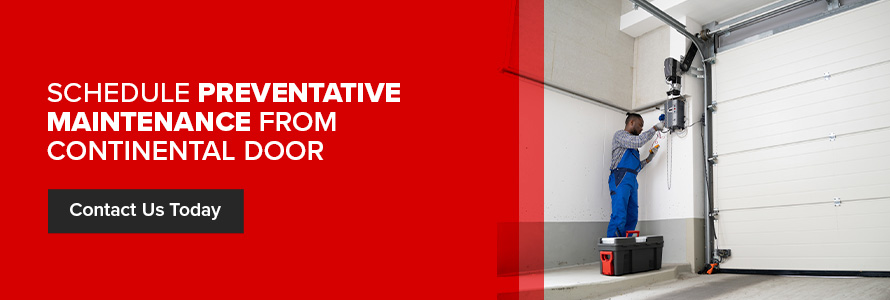
In addition to performing preventative measures you can do on your own, it’s important to work with a highly skilled and knowledgeable service team. Continental Door offers preventative maintenance services for residential and commercial garage doors in the greater Spokane area.
Contact our team today to learn more about our preventative maintenance service plans.
Insulated Garage Doors: Energy Efficiency and Cost Savings
For any property owner, choosing the right garage door is about maximizing energy efficiency, cutting costs, and ensuring optimal performance. An insulated garage door from Continental Door can help you accomplish those goals. Explore how our insulated garage doors can help you optimize energy use and save on your utility bills.
What Are Insulated Garage Doors?
Insulated garage doors feature multiple layers and typically have a core consisting of foam insulating material. That unique design offers far more than just temperature regulation — it reduces noise and enhances durability to make a space safer and more enjoyable. Insulated garage doors from top brands like Clopay® are engineered to deliver exceptional performance. We carry numerous residential garage door options from this top-performing manufacturer, including these product lines with integral or optional insulation:
- Canyon Ridge®, multiple collections
- Classic™
- Coachman®
- Gallery® Steel
- Grand Harbor®
- Modern Steel™
- Reserve® Wood, multiple collections
- Premium Series
- Value Plus Series
- Value Series
How Do Insulated Garage Doors Work?
These doors block heat transfer to maintain consistent indoor temperature by trapping air within their insulated layers. To ensure they can continue to serve that purpose, it’s important to address the following needs:
Scheduled maintenance: Regular inspection and care will help ensure your door’s longevity.
Strategic lubrication: Oiling moving parts per the manufacturer’s recommendations will keep a door operating smoothly.
Monitoring components: Checking the door, roller, and track supports is essential for promoting garage door safety and performance.
Continental Door offers commercial door inspection and repair as well as services for residential customers.
What Are the Benefits of Insulated Garage Doors?
Insulated doors are especially valuable in regions with extreme temperature fluctuations, as they work to keep your garage cool in summer and warm in winter. That protection safeguards your vehicles and any other items stored in the space. Additionally, residential insulated garage doors are excellent for busy urban settings where noise reduction is a priority. These doors also increase the property’s overall value, making them an excellent investment for homeowners aiming for both functionality and financial benefits.
Trust Continental Door as Your Garage Door Expert
Continental Door Co. stands unparalleled in our commitment to quality. Having served the greater Spokane and north Idaho area since 2000, we’re more than vendors. We offer free design consultations for new construction or retrofit projects to ensure our clients get exactly what they want.
Trust the Continental Door team to be the go-to experts for all your insulated garage door needs. Contact us today for a free estimate!
Fire-Drop Testing for School Districts
School districts are responsible for keeping hundreds — or even thousands — of students safe while they learn. Ensuring your fire doors work correctly is a critical part of protecting everyone.
What Is Fire Door Drop Testing?
Fire-rated doors in schools and other district buildings must undergo regular professional inspection to comply with government standards.
The drop-testing process encompasses two steps:
- Operation test: Your technician drops the fire doors to ensure they close smoothly and completely.
- Reset test: Your technician inspects the door’s automatic closing mechanisms to verify that you can reset them properly.
Your technician will also perform a visual inspection to check for malfunctioning operating mechanisms or damaged components. If they find none, they will verify that your fire doors can close and reset according to the standards from the National Fire Protection Association (NFPA) — specifically, NFPA 80.
Why Is Fire-Drop Testing Important?
Regular certified fire-drop testing is essential for school districts for several reasons:
- Safety: Functional fire doors can prevent harm to students and faculty by containing the spread of smoke and flames.
- Compliance: Failure to comply with the requirements in NFPA 80 and other fire safety standards can cost school districts thousands in fines and damages.
- Prevention: Inspections can reveal minor issues that can be deadly later on. Regularly performing drop tests significantly reduces the risk of something going wrong during a fire.
- Door longevity: Left unchecked, minor wear and tear can quickly turn into a costly problem. Routine testing can find damage before it escalates and help extend your door’s life span.
- Insurance: A school district’s insurance provider may have specific requirements for fire door testing beyond that of NFPA 80 or IDA regulations. Failure to comply can raise a district’s premiums.
How Often Should You Perform Fire Door Drop Tests?
According to NFPA 80, you must perform fire door testing at least once annually to ensure everything works properly. A professional fire door technician must conduct the inspection, and thorough documentation is essential for compliance.
If your technician discovers any issues during the inspection, they can recommend the repair services needed to restore your door’s functionality.
Protect Your School District With Continental Door Co.
As the leading provider of commercial garage doors in Greater Spokane and North Idaho, Continental Door can help you ensure your school buildings have the proper fire door protections in place. Contact us today for more information about our fire-rated doors and related services.
Garage Maintenance Tips That Will Save You Money
While you may not think of it often, you use your garage door several times a day. From going off to work or school in the morning to running errands throughout the day, your garage door gets opened and closed many times.
Because there are so many moving parts that can wear out or break, it’s important to take time to maintain your garage door.
How to Save Money on Your Garage
Garage door repairs and replacements can be costly. To save money, check out a few garage maintenance tips that will ensure your door lasts for years.
Limit Garage Door Use as Much as Possible
The more you use your garage door, the faster all of the moving parts will wear out. Instead of using your garage door to enter and exit your home — like when you go out to get the mail or a package — use your front door instead.
Perform Regular Garage Door Inspections
Be sure to regularly look and listen for potential issues with your garage door. When you inspect it, look for signs of wear and tear like loose or bent hinges. Tighten any loose bolts or brackets. Pay attention to cables or springs that look asymmetrical.
You also want to notice if the door is running smoothly or if it gets caught or makes grinding sounds. Catching potential issues early on can help you avoid costly repairs.
Lubricate Your Garage Door
To make sure your garage door runs smoothly, keep all moving parts lubricated. You can use some light household oil on the overhead springs and rollers. If you’ve noticed your door has been squeaking or more noisy than usual, it’s probably time to lubricate it!
Keep Your Garage Door Tracks Clean
Your garage door tracks need to be clean to ensure your door can freely open and close as it should. Take a few minutes to brush away any debris or leaves that could be blocking the track. Be sure to check and clean both tracks on the side of the door.
Change Your Lights
Another way to save money with your garage door maintenance is to change out your lights. Instead of using regular lightbulbs, which don’t last long, switch to LEDs to save on your electricity bill each month.
Request Garage Door Service From Continental Door
If you are in the greater Spokane area and your garage door hasn’t been running as it should, turn to the team of experts at Continental Door. We can repair everything from coiling doors to garage door openers.
Reach out today to receive a free estimate or schedule a repair service.
10 Reasons Your Garage Door Won’t Close and How to Troubleshoot This Issue
Your garage door is a crucial part of your daily life, but you might not give it a second thought when it’s working correctly. If it stops working, that’s a whole different issue. When your garage door won’t go down, your day comes to a screeching halt. You’re busy enough — the last thing you need is a faulty garage door.
What do you do when your garage door won’t close? If you want to know how to troubleshoot a garage door that’s not closing, you’ve come to the right place. To help you solve the problem, our experts at Continental Door have assembled this list of the top reasons garage doors won’t close.
Contact Our Team For Garage Door Repair1. The Opener Is Getting No Power
“Why won’t my garage door close?” The good news is that the fix doesn’t have to cost you hundreds of dollars and days of frustration. Your garage door opener needs electric power to open and close your door. The first thing you should do when your door won’t close is to check whether power is getting to your garage door opener. This problem has a couple of quick fixes that will only take you a few minutes to perform.
Your garage door opener should plug into a nearby outlet on the ceiling or a wall. If you were cleaning your opener, it’s possible you accidentally knocked the plug from the outlet. It’s a snap to do this if the plug is loose in a ceiling outlet. Plug it back in if it fell out, then try closing your garage door again.
If you still have it plugged in, you may have lost power or tripped the circuit. Ensure surrounding lights, electronics and electrical appliances are still working. If so, check your breaker box to see if you need to reset it to send power back to your garage door opener. After flipping the breaker switch back on, give your opener another try to close the garage door.
2. Your Transmitter’s Batteries Are Dead
The problem could be as simple as your transmitter or remote having dead batteries. A garage door remote’s batteries can die at any moment, including after you’ve used it to open the garage door. If your garage door opener is receiving power but not responding when you press the remote, see if it needs a new set of batteries.
First, try using your wall-mounted garage door opener button or outdoor keypad to close the garage door. If these don’t work, you could have a more prominent issue. If they still work, there’s a good chance your remote has dead batteries.
Slide off the backplate or use a screwdriver to access the transmitter’s batteries. Identify the type you need and replace them. Opener remotes tend to use standard household batteries such as AA, AAA or flat disc batteries. Your local hardware store should keep these in stock if you don’t have any. Once you’ve reattached the backplate, try closing your garage door again. If it works, you’re ready to get back to your day’s agenda with confidence that your remote will work for the foreseeable future.
3. Something Is Blocking the Remote Signal
Your remote has a small antenna that communicates with the antenna on your garage door opener. If something is in the antennas’ path when you try to close your garage door, your opener may be unable to receive the command from your remote. If you’ve replaced the batteries and the remote still doesn’t work, see if there are any obstructions.
Your remote may have an external antenna housed within a small plastic bubble. Gently wipe the bubble to clean away any dirt or smudges that could be blocking your signal. Next, make sure you’re pointing your remote at your opener when you press the button. Tree branches or other natural obstructions could also be getting in the signal’s path. Clear them away and see if this solves your issue.
Next, check the opener itself for signs of damage. If the opener’s antenna is broken, a functional remote still won’t close your garage door. You may need to call a professional garage door company to fix the issue.
There’s also a chance that your batteries are weakening. You may want to replace them before they die. A remote with weak batteries might only work within a few feet of the garage door opener. Replace the batteries and see if this gives you the range you’re familiar with.
4. Someone Has Pulled the Cord Switch
Your garage door opener should have a dangling red string known as the safety cord. When you pull this, it disconnects the garage door from the opener, which lets you open and close the garage door manually during power outages and other events. There’s a chance someone in your household pulled the cord switch without your knowledge. Or, you may have forgotten you gave it a pull earlier in the day. No worries! It happens to us all.
The cord switch has two settings — pulled away from the opener for disconnection, and pulled toward the opener for connection. Try pulling the cord toward the opener first, as this should reconnect a detached cord switch. Then, try using your remote to close the garage door. If this solves your issue, your problem was a disconnected cord switch. If not, you may have a more severe issue on your hands involving your garage door opener.
5. The Opener Has a Motor Circuit or Mechanical Failure
If the above troubleshooting recommendations didn’t solve your issue, the solution might be more complicated and expensive. Your garage door opener may have a motor circuit or mechanical failure. Both these issues will stop your garage door opener from opening and closing. Since they involve tinkering with your garage door’s inner workings, your best bet might be to call a professional.
If something is wrong with your opener’s motor circuit, you may be able to get a replacement, especially if your opener is still relatively new and has a warranty protecting it from malfunctions. The problem could either be a factory error or an unfortunate natural cause, such as a lightning strike. Call your garage door opener’s manufacturer to ask about their replacement policy.
Your garage door gets a lot of use. Consider if you open and close your garage door twice per day — once when you leave in the morning and once when you come home. Assuming you work five days per week, that adds up to more than 500 times per year. If multiple people live in your household, chances are you use your garage door even more often. That puts a lot of wear and tear on your opener, so it’s normal for it to suffer a mechanical failure.
Call a professional and see if they can repair your garage door opener. If you have an old opener, your best option may be to get a new one.
6. Something Is Blocking the Door
There could be a simple reason your garage door starts to close, then reverses. The government requires automatic garage door manufacturers to equip doors with several safety features. These include a function that causes garage doors to switch direction if something gets in their way as they close. When the door meets the item, a resistance-based function trigger makes the door back up to protect the door and the object. This feature is essential in protecting children or pets at play around garage doors.
Look around the floor beneath your garage door’s closing path. There might be a small blockage in the way, like a child’s toy or even a small rock from the driveway. Remove anything on the floor in that area and see if that solves the issue.
While you’re there, you should test this safety feature to make sure it works. Place a wooden block beneath the garage door and press the button to close the garage door. Once the door meets the block, it should automatically start backing up. If the door keeps pushing against the wooden block, press your remote to reverse its direction. You’ll need to call a professional to recalibrate this safety feature.
7. The Sensors Are Misaligned or Obstructed
Most modern garage doors have another safety feature that uses photo-eye sensors for protection. These sensors sit a few inches above the ground on both sides of the door. They use tiny cameras to “see” if anything is beneath the garage door as it closes. If anything is in the photo sensor’s path, the garage door will not close. It could also stop in its tracks or reverse its direction to protect whatever is underneath it.
First, see if anything passed through the sensors when you tried closing the garage door. Clean the floor beneath your garage door and try closing it again. If the problem persists, take a soft rag and gently wipe the photosensor lenses. There could be dirt or debris obstructing the sensors’ vision. You should also make sure the two sensors’ lenses are facing each other. If they are out of line, the garage door won’t be able to close all the way or at all.
Check out Continental Door’s photo-eye troubleshooting video for more information on fixing this issue.
8. Your Springs Are Worn or Broken
Your garage door opening system uses springs to get the job done. These can include one or two torsion springs above the garage door and two extension springs attached to cables that lift your garage door from the ground. Every spring has a cycle lifespan. If your springs have reached the end of their cycle rating, they could be on the verge of breaking, if they have not broken already. A broken torsion or extension spring may be preventing your garage door from closing.
If you opened your garage door and heard a loud, gunshot-like sound, you might have a broken spring somewhere in your garage door assembly. These are essential pieces of your garage door, so you should call a professional to repair your spring issue.
Since springs are under a lot of tension and pressure, you should never attempt to fix a spring issue yourself. You could suffer severe injuries if something goes wrong. If you suspect a broken spring is the reason your garage door won’t close, call a professional right away.
9. The Roller Tracks Are Misaligned
Does your door slow down as it opens or closes when it passes a specific spot? Can you hear a squeaking, grinding or grating sound during operation? Your roller tracks might be out of line.
Your garage door has little wheels on both sides that allow it to move up and down through the roller tracks. The roller tracks need to be straight and aligned for proper functioning. If one of your roller tracks suffers even minor damage, it could throw your garage door out of alignment, which can slow it down or threaten to stop it in its tracks altogether.
Use a long level to see if any section of the track has gotten bent or misaligned. If you detect that the two sides of the tracks are not plumb, you’ll need to call a professional to repair them. Left unaddressed, this issue can get worse over time, leading to more costly repairs. Having straight roller tracks will keep your garage door opening and closing with ease for years to come.
10. There Is an Error in the Limit Settings
If your garage door won’t close all the way, or it reverses after it touches the ground, your opener may have an error in its limit settings. The limit setting is the calibrated distance that tells the garage door opener how far it needs to send the garage door to reach the ground. This setting can drift over time and require recalibration.
If the setting is too high, the opener will mistake it as an obstruction, which will trigger the automatic reversal safety feature. If the setting is too low, the garage door might stop before it reaches the ground, leaving a gap between the door and the floor. This error can be tricky to fix, so call a professional to recalibrate your opener’s limit settings if this seems to be your problem.
Request Garage Door Service From Continental Door
If you’re still having garage door problems after trying these troubleshooting methods, request service from Continental Door. We’ve been serving the greater Spokane and Northern Idaho regions for over 15 years. And since we understand garage door issues can strike at any time, we offer 24-hour emergency services to help you in a crisis.
We are ready to assist with all your residential garage door needs. Don’t let another day go by with a faulty garage door. With our help, you can get back to your typical routine with a functioning garage door. Contact us today to learn more about how we can serve you.
Contact Us7 Ways to Improve Garage Energy Efficiency
An energy-efficient garage keeps your home comfortable and reduces your monthly energy bills. Insulation and tight seals around your doors, windows and walls prevent warm air inside from leaking outside. These components also prevent cold air drafts from coming into your home in the winter.
If you’re wondering how to make your garage more energy efficient, these tips can help. Your garage is part of the rest of your house, so any drafts or changes in temperature can affect your kitchen, living room and bedrooms as well. If you have a detached garage, you may want to increase its energy efficiency to make it more useful as an office or an accessory dwelling unit (ADU). Keep the following energy-saving tips for the garage in mind as you renovate your space.
1. Insulate Your Garage Door, Walls and Ceiling
One of the most effective ways to save energy in your garage is to install insulation. This durable material acts as a thermal barrier against outdoor temperatures and humidity. Look for a product with a high R-value to provide maximum protection from cold air drafts. Consider insulating the following parts of your garage:
- Garage door: The garage door protects the garage from outdoor weather conditions, but cracks, small openings and outdated insulation can bring the cold air inside. You could either purchase an insulation kit from your local hardware store or invest in a brand-new insulated garage door. A kit features double-bubble radiant or foam board insulation, but an insulated garage door features polyurethane or polystyrene layers. Though installing insulation yourself may be more affordable, it won’t be as effective as buying a new garage door.
- Garage walls: Besides insulating the garage door, you can also apply insulation to the walls to maximize your home’s energy efficiency. If you have an older home, there might not be enough insulation in your garage. Choose the appropriate R-value for your insulation based on where you live. As you install insulation on your walls, you may also want to insulate the light switches and outlets.
- Garage ceiling: Since warm air rises, the heat from your furnace or space heater could travel upward and outside if your garage doesn’t have adequate insulation. To prevent this loss of energy, you may want to install insulation on the ceiling. When you have a protective barrier at the top of your garage, the heat from your HVAC system will stay inside, creating a comfortable place when you get out of your car and enter your home.
2. Use Caulk or Sealant to Seal Gaps
To save energy in the garage, seal the gaps around your doors and windows. The various building materials in your garage can expand and shrink when exposed to fluctuating temperatures. As a result, air from your HVAC system can escape through the holes, leaks, cracks and other openings to the outside.
Follow these tips for sealing gaps in the various parts of your garage:
- Inspect the walls, door and windows: Look around your garage for gaps and openings around your walls, door and windows. Note where you see worn-out window frames and cracks in the walls so you know where you need to apply the sealant.
- Clean the openings: Before you start sealing the gaps around your doors and windows, clean the area to ensure a proper seal. You can clean grime and dirt off the tracks with a vinegar solution in a spray bottle, then wipe the space with a paper towel.
- Use silicone or foam sealant: To seal the gaps in your garage door and windows, apply a thin bead of silicone caulk or foam sealant. These small materials fit in your doors and window cracks to prevent heat from leaving your garage in the winter. Put the sealer on the window and door’s interior and exterior to guard against drafts in both directions.
- Only caulk the top and sides: Instead of caulking the entire window, only apply the silicone to the trim at the top and sides. Leaving the bottom unsealed will prevent dripping water from coming inside and allow condensation to escape.
3. Apply an Epoxy Coating to Your Garage Floor
Besides sealing your doors and windows, you can also make your garage more energy efficient by sealing the floor. Cracks in your concrete floor may be leaking heat into the ground underneath your property. Filling in these fractures will help you stay warm in the winter. Follow these tips for sealing your garage floor:
- Clean your garage floor: To clear debris off your concrete floor, use a power washer filled with a specialized cleaner. After spreading the detergent, scrub the floor with a push broom and rinse the soap off the surface. Wait for the floor to dry before applying the sealant.
- Coat your garage floor with epoxy: You can use an epoxy coating to cover minor imperfections in the concrete. Spread the product evenly across the garage floor with a paint pad. Refer to the manufacturer’s instructions for how long you should let the coating soak in and dry before putting your car or other valuables back into the garage.
- Fill in cracks with a sandable compound: Use a sandable crack-filling product to fill in significant gaps. When this substance cures and hardens, it becomes stronger than concrete and prevents water from leaking into the fractures.
4. Seal the Door That Connects Your House to the Garage
As you inspect your garage for imperfections, check the door that leads into the central part of your home. If you have an attached garage, the drafts from the garage can blow in through gaps in the door, affecting your kitchen, dining room, living room or bedroom. You can seal your door using any of the following methods:
- Update the weatherstripping: The weatherstripping around the entire door frame should be intact to keep drafts out of your main living area. To check whether your door has any openings, you can turn off the light in your garage and look for light shining through from the other side. If you see the light from the primary part of your house, apply weatherstripping around the door frame to create a tight, energy-efficient seal.
- Put in a draft stopper: The threshold under your door should be sturdy, but after excessive use, it tends to lose its quality. If this component doesn’t have a proper seal, you can put in a draft stopper as a temporary solution. For a few more dollars, you can also have a professional replace the door’s threshold.
- Caulk or seal small openings: You may also want to apply a sealant to any small gaps around the door, including the interior and exterior trim. This decorative trim should have a proper seal around it. Over the years, the vinyl or wood can expand and contract as the temperature changes.
5. Update Your Lighting
You may live in an older home, or you may not have renovated your property in a while. In that case, your lighting might be outdated and using more energy than necessary. Switching to LED lights is a simple upgrade for a more efficient and eco-friendly garage.
Instead of lighting your garage with incandescent or fluorescent bulbs, using LED lights can save you money on energy costs. An LED bulb generates the same amount of light and uses about 75% less energy than an incandescent one. Since energy-efficient light bulbs have a longer life span, you’ll save money on resources over time. You may also want to invest in a light timer to automatically turn off your lights when you’re not using them.
6. Install Energy-Efficient Windows
You might want to replace the windows in your garage. Energy-efficient glass panes help you save money on your energy bills and make your living space more comfortable. Your windows can let in a lot of moisture and drafts if they’ve lost their seal, contributing to 25% to 30% of residential heating and cooling energy use.
When shopping for energy-efficient windows, look for these qualities:
- Multiple window glass panes: Your windows will be more energy efficient if they have two or three glass panes sandwiched together with spaces between them. The gaps create pockets that have a tight seal to prevent air leaks.
- Durable window frame materials: Look for sturdy, long-lasting window frames. Wood, clad-wood, vinyl or fiberglass window frames have high insulation qualities to help reduce air drafts and keep your garage warmer in the winter.
- Low-E glass coatings: Low-emissivity coatings can keep the inside of your home warm by controlling how the heat from the sunlight enters through your windows. An exterior Low-E coating prevents heat from coming into your home while still allowing sunlight inside. Similarly, the heat from your furnace doesn’t escape through your windows to the outside.
- Window gas fills: Energy-efficient windows contain argon or krypton between the glass to increase their resistance to the weather conditions outside. These gases are colorless, odorless and non-toxic, so they won’t harm your garage’s indoor air quality.
- Window spacers: Your energy-efficient windows will have spacers installed within them at the perfect distance apart to reduce heat transfer. This energy-efficient feature keeps heat from your furnace inside your garage instead of leaking outside.
If you’re looking for a more affordable alternative to new windows, use silicone caulk or weatherstripping along the trim and frames to make them more resistant to heat transfer.
7. Organize Your Garage Storage
Reducing the clutter in your garage can help make it more energy efficient. If there are piles of junk on the floor or shelves, you may invite pests into your property. Insects and rodents chew through insulation and wires, posing a threat to your HVAC system and making your living space much less comfortable. With clutter in your garage, you may not notice a pest infestation until it’s too late.
Clutter may also make it challenging to keep the temperature comfortable. Boxes and piles of papers may block HVAC or dryer vents, putting more of a strain on your appliances. You may want to invest in garage storage units or a shed to clear up some space. Here are some steps you can take to declutter and organize your garage:
- Clear out your garage: The best time to organize your garage is when the weather is pleasant. On a sunny day, you can bring your belongings to your driveway to sort through them. In the winter, you can use a few bins to keep everything in one place. While your floor is empty, you may want to vacuum, sweep or apply an epoxy coating.
- Sort your items: Throw away all trash, such as loose pieces of paper and dead insects. Then, create piles to keep, trash, relocate and donate for the rest of your belongings. You may want to go through every box and shelf to find items you may have forgotten were in the garage.
- Split the garage into zones: After figuring out what things you want to keep in the garage, split them into categories, such as tools, car equipment and office supplies. Grouping like items together allows you to determine how much room you’ll need for each zone.
- Be creative with your storage: Make the most out of the space in your garage by organizing your belongings strategically. Install shelves, hooks and cabinets on your walls, ceiling and floor to leave room for your car. You should also store toxic, dangerous items in locked cabinets far from reach of children.
- Regularly maintain your garage: After you’ve established a storage system that works for you, create a schedule for cleaning your garage. Clutter may pile up over time, but you can follow a cleaning routine to save time and make the process more manageable. In addition to picking up loose items, sweep your garage floor and look for potential places where pests can hide.
Get Insulated Garage Doors From Continental Door
Following these garage energy efficiency tips can help make your living space more comfortable and save you money on your monthly expenses. To make your garage more energy efficient, consider installing a brand-new garage door with polyurethane or polystyrene insulation. This durable material goes between your garage door panels to protect your home against outdoor elements.
Continental Door has a wide variety of insulated garage door options among our residential garage door products available in Spokane and Northern Idaho. We’ll help you find the ideal product for your home to keep you warm in the winter, and we’ll install it with a tight seal to keep out cold air. For more information about how to make your garage more comfortable, reach out to us online or call 509-921-2260.

